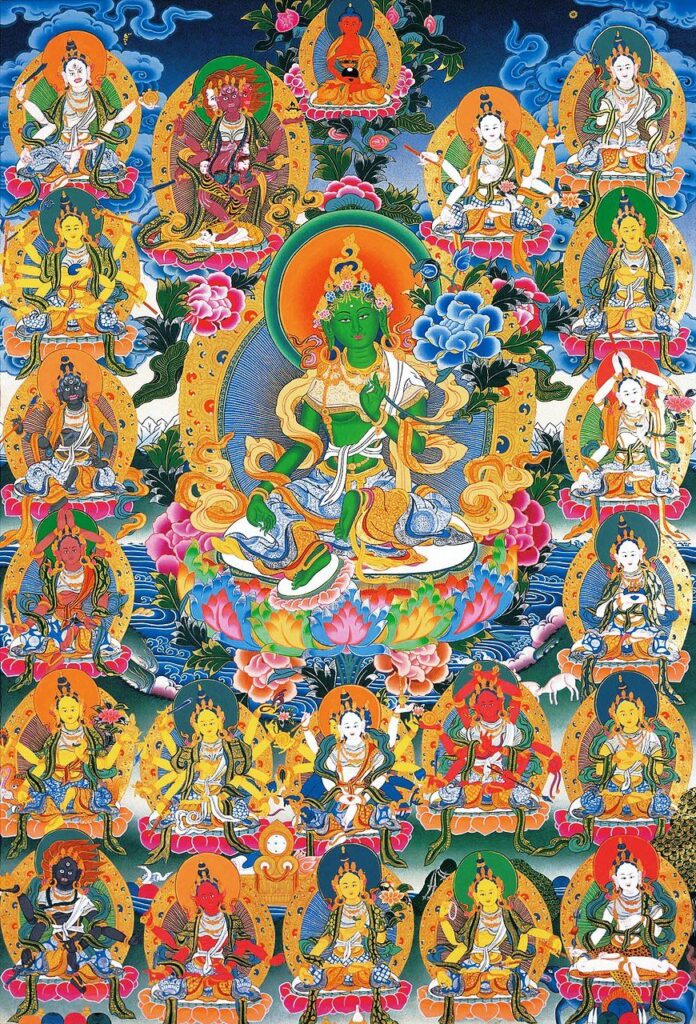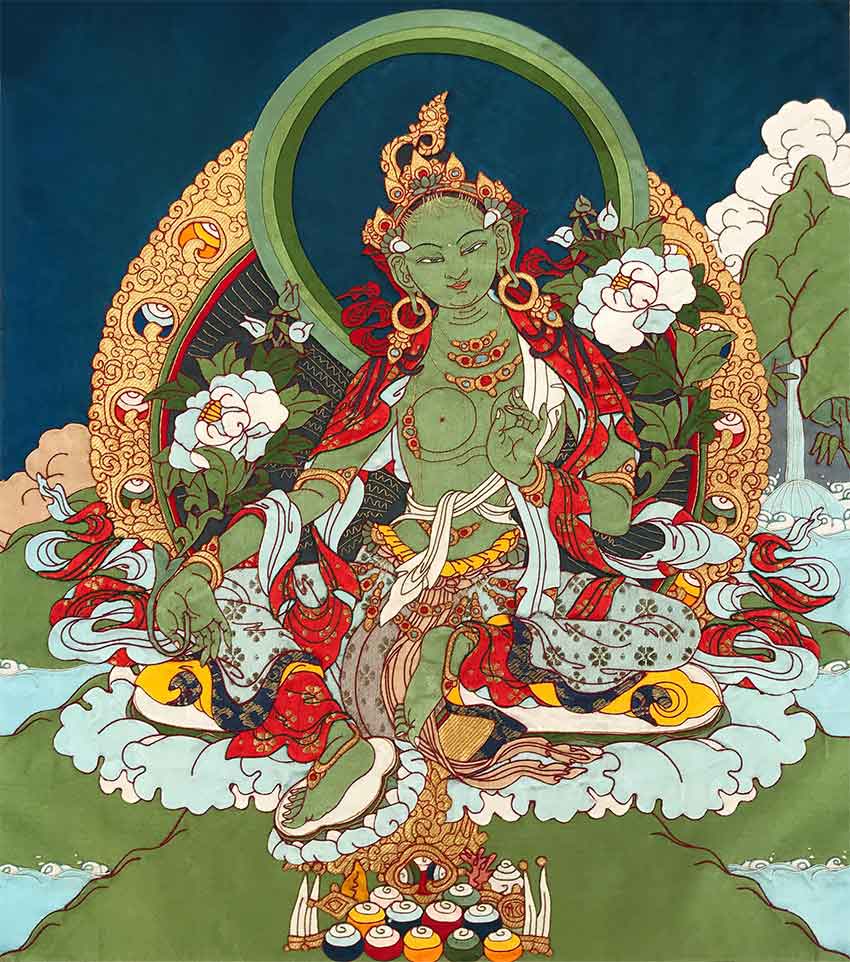21 Tara with 21 specific colors serves a specific function. There are different styles and designs of tangka paintings that represent the 21 manifestations of Tara based on distinct lineages and practices, in which forms, colors, ritual objects, and even names or functions can vary.
“I have developed bodhicitta as a woman. For all my lifetimes along the path I vow to be born as a woman, and in my final lifetime when I attain Buddhahood, then, too, I will be a woman.”
The goddess Tara, the most beloved of all-female enlightened beings in Buddhism. Our ultimate devotion and faith help us awaken our Buddha nature, hence helping in establishing a close relationship with goddess Tara based upon trust, respect, reverence, and relying on her during difficult times. Goddess Tara is born out of compassion and wisdom from the Lord Avalokiteśvara or the “lord that looks down”. Lord Avalokitesvara on seeing the intense sufferings being inflicted upon the sentient beings wept out of compassion formed a lake out of his tears. From this lake, sprang forth a lotus from which the goddess Tara emerged.
So goddess Tara’s origination was birthed from the compassion promised to look after the sufferings of the sentient beings. If you look at the picture of goddess Tara, you will notice that the right foot of goddess Tara is slightly extended indicating her willingness to leap at the time of need of sentient beings. Her right hand is opened out on her right knee, in the gesture of her generosity. Her left hand holds the stem of a lotus flower, which is blossoming next to her left ear. We need to approach Tara with an open heart and mind.
Goddess Tara’s meaning and importance eventually took different interpretations depending on different faiths within Buddhism itself. There are 21 different Tara’s grouped around a central green Tara. Each one represented different aspects of divinity.
Her Meaning and Importance Tara eventually took on multiple “interpretations” in Buddhism, which led to depictions of different colors. Each one represented a different aspect of Divinity.
The most common thangka art of Twenty-one Taras present Green Tara in the center of the composition but in some thangkas, the central position can be occupied by Red Tara or White Tara.
Table of Contents
Tara mantra
OM TARE TUTTARE TURE SVAHAThrough this mantra, we take refuge in the Goddess Tara to liberate us from the world of sufferings. TARE means we seek the help of Goddess Tara to liberate all beings from the mortal world and TUTTARE means to liberate from fear.
Mantra of Tara in Tibetan language


Prayers to 21 Tara in Tibetan
༈ པོ་ཏ་ལ་ཡི་གནས་མཆོག་ནས། །ཏཱཾ་ཡིག་ལྗང་གུ་ལས་འཁྲུངས་ཤིང༌། ། ཏཱཾ་ཡིག་འོད་ཀྱིས་འགྲོ་བ་སྒྲོལ། །སྒྲོལ་མ་འཁོར་བཅས་གཤེགས་སུ་གསོལ། །ལྷ་དང་ལྷ་མིན་ཅོད་པན་གྱིས། །ཞབས་ཀྱི་པདྨོ་ལ་བཏུད་དེ། །ཕོངས་པ་ཀུན་ལས་སྒྲོལ་མཛད་པའི། །སྒྲོལ་མ་ཡུམ་ལ་ཕྱག་འཚལ་ལོ། །རྗེ་བཙུན་འཕགས་མ་སྒྲོལ་མ་དང༌། །ཕྱོགས་བཅུ་དུས་གསུམ་བཞུགས་པ་ཡི། །རྒྱལ་བ་སྲས་བཅས་ཐམས་ཅད་ལ། །ཀུན་ནས་དྭང་བས་ཕྱག་བགྱིའོ། །མེ་ཏོག་བདུག་སྤོས་མར་མེ་དྲི། །ཞལ་ཟས་རོལ་མོ་ལ་སོགས་པ། ། དངོས་བཤམས་ཡིད་ཀྱིས་སྤྲུལ་ནས་འབུལ། །འཕགས་པའི་ཚོགས་རྣམས་བཞེས་སུ་གསོལ། །ཐོག་མ་མེད་ནས་ད་ལྟའི་བར། །མི་དགེ་བཅུ་དང་མཚམས་མེད་ལྔ། །སེམས་ནི་ཉོན་མོངས་དབང་གྱུར་པའི། །སྡིག་པ་ཐམས་ཅད་བཤགས་པར་བགྱི། །ཉན་ཐོས་རང་རྒྱལ་བྱང་ཆུབ་སེམས། །སོ་སོ་སྐྱེ་བོ་ལ་སོགས་པས། །དུས་གསུམ་དགེ་བ་ཅི་བསགས་པའི། །བསོད་ནམས་ལ་ནི་བདག་ཡི་རང༌། །སེམས་ཅན་རྣམས་ཀྱི་བསམ་པ་དང༌། །བློ་ཡི་བྱེ་བྲག་ཇི་ལྟར་བར། །ཆེ་ཆུང་ཐུན་མོང་ཐེག་པ་ཡི། །ཆོས་ཀྱི་འཁོར་ལོ་སྐོར་དུ་གསོལ། །འཁོར་བ་ཇི་སྲིད་མ་སྟོངས་བར། །མྱ་ངན་མི་འདའ་ཐུགས་རྗེ་ཡིས། ། སྡུག་བསྔལ་རྒྱ་མཚོར་བྱིང་བ་ཡི། །སེམས་ཅན་རྣམས་ལ་གཟིགས་སུ་གསོལ། །བདག་གིས་བསོད་ནམས་ཅི་བསགས་པ། །ཐམས་ཅད་བྱང་ཆུབ་རྒྱུར་གྱུར་ནས། །རིང་པོར་མི་ཐོགས་འགྲོ་བ་ཡི། །འདྲེན་པའི་དཔལ་དུ་བདག་གྱུར་ཅིག །
༈ ཨོཾ་རྗེ་བཙུན་མ་འཕགས་མ་སྒྲོལ་མ་ལ་ཕྱག་འཚལ་ལོ། །ཕྱག་འཚལ་སྒྲོལ་མ་མྱུར་མ་དཔའ་མོ། །སྤྱན་ནི་སྐད་ཅིག་གློག་དང་འདྲ་མ། །འཇིག་རྟེན་གསུམ་མགོན་ཆུ་སྐྱེས་ཞལ་གྱི། །གེ་སར་བྱེ་བ་ལས་ནི་བྱུང་མ། །ཕྱག་འཚལ་སྟོན་ཀའི་ཟླ་བ་ཀུན་ཏུ། །གང་བ་བརྒྱ་ནི་བརྩེགས་པའི་ཞལ་མ། །སྐར་མ་སྟོང་ཕྲག་ཚོགས་པ་རྣམས་ཀྱིས། །རབ་ཏུ་ཕྱེ་བའི་འོད་རབ་འབར་མ། །ཕྱག་འཚལ་སེར་སྔོ་ཆུ་ནས་སྐྱེས་ཀྱི། །པདྨའི་ཕྱག་ནི་རྣམ་པར་བརྒྱན་མ། ། སྦྱིན་པ་བརྩོན་འགྲུས་དཀའ་ཐུབ་ཞི་བ། །བཟོད་པ་བསམ་གཏན་སྤྱོད་ཡུལ་ཉིད་མ། ། ཕྱག་འཚལ་དེ་བཞིན་གཤེགས་པའི་གཙུག་ཏོར། །མཐའ་ཡས་རྣམ་པར་རྒྱལ་བར་སྤྱོད་མ། །མ་ལུས་ཕ་རོལ་ཕྱིན་པ་ཐོབ་པའི། །རྒྱལ་བའི་སྲས་ཀྱི་ཤིན་ཏུ་བསྟེན་མ། །ཕྱག་འཚལ་ཏུཏྟཱ་ར་ཧཱུཾ་ཡི་གེས། །འདོད་དང་ཕྱོགས་དང་ནམ་མཁའ་གང་མ། །འཇིག་རྟེན་བདུན་པོ་ཞབས་ཀྱིས་མནན་ཏེ། །ལུས་པ་མེད་པར་འགུགས་པར་ནུས་མ། །ཕྱག་འཚལ་བརྒྱ་བྱིན་མེ་ལྷ་ཚངས་པ། །རླུང་ལྷ་སྣ་ཚོགས་དབང་ཕྱུག་མཆོད་མ། །འབྱུང་པོ་རོ་ལངས་དྲི་ཟ་རྣམས་དང༌། །གནོད་སྦྱིན་ཚོགས་ཀྱིས་མདུན་ནས་བསྟོད་མ། །ཕྱག་འཚལ་ཏྲད་ཅེས་བྱ་དང་ཕཊ་ཀྱིས། །ཕ་རོལ་འཁྲུལ་འཁོར་རབ་ཏུ་འཇོམས་མ། །གཡས་བསྐུམས་གཡོན་བརྐྱང་ཞབས་ཀྱིས་མནན་ཏེ། །མེ་འབར་འཁྲུགས་པ་ཤིན་ཏུ་འབར་མ། །ཕྱག་འཚལ་ཏུ་རེ་འཇིགས་པ་ཆེན་པོ། །བདུད་ཀྱི་དཔའ་བོ་རྣམ་པར་འཇོམས་མ། །ཆུ་སྐྱེས་ཞལ་ནི་ཁྲོ་གཉེར་ལྡན་མཛད། །དགྲ་བོ་ཐམས་ཅད་མ་ལུས་གསོད་མ། ། ཕྱག་འཚལ་དཀོན་མཆོག་གསུམ་མཚོན་ཕྱག་རྒྱའི། །སོར་མོས་ཐུགས་ཀར་རྣམ་པར་བརྒྱན་མ། །མ་ལུས་ཚོགས་ཀྱི་འཁོར་ལོས་བརྒྱན་པའི། །རང་གི་འོད་ཀྱི་ཚོགས་རྣམས་འཁྲུག་མ། །ཕྱག་འཚལ་རབ་ཏུ་དགའ་བ་བརྗིད་པའི། །དབུ་རྒྱན་འོད་ཀྱི་ཕྲེང་བ་སྤེལ་མ། །བཞད་པ་རབ་བཞད་ཏུཏྟཱ་ར་ཡིས། །བདུད་དང་འཇིག་རྟེན་དབང་དུ་མཛད་མ། ། ཕྱག་འཚལ་ས་གཞི་སྐྱོང་བའི་ཚོགས་རྣམས། །ཐམས་ཅད་འགུགས་པར་ནུས་མ་ཉིད་མ། །ཁྲོ་གཉེར་གཡོ་བའི་ཡི་གེ་ཧཱུཾ་གིས། །ཕོངས་པ་ཐམས་ཅད་རྣམ་པར་སྒྲལ་མ། ། ཕྱག་འཚལ་ཟླ་བའི་རྩེ་མོས་དབུ་བརྒྱན། །བརྒྱན་པ་ཐམས་ཅད་ཤིན་ཏུ་འབར་མ། །རལ་བའི་ཁྲོད་ན་འོད་དཔག་མེད་ལས། །རྟག་པར་ཤིན་ཏུ་འོད་རབ་མཛད་མ། །ཕྱག་འཚལ་བསྐལ་པའི་ཐ་མའི་མེ་ལྟར། །འབར་བའི་ཕྲེང་བའི་དབུས་ན་གནས་མ། །གཡས་བརྐྱངས་གཡོན་བསྐུམས་ཀུན་ནས་བསྐོར་དགའི། །དགྲ་ཡི་དཔུང་ནི་རྣམ་པར་འཇོམས་མ། །ཕྱག་འཚལ་ས་གཞིའི་ངོས་ལ་ཕྱག་གི །མཐིལ་གྱིས་བསྣུན་ཅིང་ཞབས་ཀྱིས་བརྡུང་མ། །ཁྲོ་གཉེར་སྤྱན་མཛད་ཡི་གེ་ཧཱུཾ་གིས། །རིམ་པ་བདུན་པོ་རྣམས་ནི་འགེམས་མ། །ཕྱག་འཚལ་བདེ་མ་དགེ་མ་ཞི་མ། །མྱ་ངན་འདས་ཞི་སྤྱོད་ཡུལ་ཉིད་མ། །སྭཱ་ཧཱ་ཨོཾ་དང་ཡང་དག་ལྡན་པས། །སྡིག་པ་ཆེན་པོ་འཇོམས་པ་ཉིད་མ། །ཕྱག་འཚལ་ཀུན་ནས་བསྐོར་རབ་དགའ་བའི། །དགྲ་ཡི་ལུས་ནི་རབ་ཏུ་འགེམས་མ། །ཡི་གེ་བཅུ་པའི་ངག་ནི་བཀོད་པའི། །རིག་པ་ཧཱུཾ་ལས་སྒྲོལ་མ་ཉིད་མ། །ཕྱག་འཚལ་ཏུ་རེའི་ཞབས་ནི་བརྡབས་པས། །ཧཱུཾ་གི་རྣམ་པའི་ས་བོན་ཉིད་མ། །རི་རབ་མན་དྷ་ར་དང་འབིགས་བྱེད། ། འཇིག་རྟེན་གསུམ་རྣམས་གཡོ་བ་ཉིད་མ། །ཕྱག་འཚལ་ལྷ་ཡི་མཚོ་ཡི་རྣམ་པའི། །རི་དྭགས་རྟགས་ཅན་ཕྱག་ན་བསྣམས་མ། །ཏཱ་ར་གཉིས་བརྗོད་ཕཊ་ཀྱི་ཡི་གེས། །དུག་རྣམས་མ་ལུས་པ་ནི་སེལ་མ། །ཕྱག་འཚལ་ལྷ་ཡི་ཚོགས་རྣམས་རྒྱལ་པོ། །ལྷ་དང་མིའམ་ཅི་ཡིས་བསྟེན་མ། །ཀུན་ནས་གོ་ཆ་དགའ་བའི་བརྗིད་ཀྱིས། །རྩོད་དང་རྨི་ལམ་ངན་པ་སེལ་མ། །ཕྱག་འཚལ་ཉི་མ་ཟླ་བ་རྒྱས་པའི། །སྤྱན་གཉིས་པོ་ལ་འོད་རབ་གསལ་མ། །ཧ་ར་གཉིས་བརྗོད་ཏུཏྟཱ་ར་ཡིས། །ཤིན་ཏུ་དྲག་པོའི་རིམས་ནད་སེལ་མ། །ཕྱག་འཚལ་དེ་ཉིད་གསུམ་རྣམ་བཀོད་པས། །ཞི་བའི་མཐུ་དང་ཡང་དག་ལྡན་མ། །གདོན་དང་རོ་ལངས་གནོད་སྦྱིན་ཚོགས་རྣམས། །འཇོམས་པ་ཏུ་རེ་རབ་མཆོག་ཉིད་མ། །རྩ་བའི་སྔགས་ཀྱིས་བསྟོད་པ་འདི་དང༌། །ཕྱག་འཚལ་བ་ནི་ཉི་ཤུ་རྩ་གཅིག །
Praises to the Twenty-one Tara In (English version for chanting)
English version for chanting of the 21 tara as follow.
OM I prostrate to the noble transcendent liberator.
OM je tsün ma phag ma dröl ma la chhag tshäl lo
1. Homage! Tara, swift, heroic!
Eyes like lightning instantaneous!
Sprung from op’ning stamens of the
Lord of three world’s tear-born lotus!
2. Homage! She whose face combines a
Hundred autumn moons at the fullest!
Blazing with light rays resplendent
As a thousand-star collection!3. Homage! Golden-blue one, lotus
Water born, in hand adorned!
Giving, effort, calm, austerities,
Patience, meditation her sphere!
4. Homage! Crown of tathagatas,
Actions triumph without limit!
Relied on by conquerors’ children,
Having reached ev’ry perfection!5. Homage! Filling with TUTTARE,
HUM, desire, direction, and space!
Trampling with her feet the seven worlds,
Able to draw forth all beings!6. Homage! Worshipped by the all-lords,
Shakra, Agni, Brahma, Marut!
Honored by the hosts of spirits,
Corpse-raisers, Gandharvas, yakshas!
7. Homage! With Her TRAD and PHAT sounds
Destroying foes’ magic diagrams!
Her feet pressing, left out, right in,
Blazing in a raging fire-blaze!
8. Homage! TURE, very dreadful!
Destroyer of Mara’s champion(s)!
She with frowning lotus visage
Who is slayer of all enemies!
9. Homage! At the heart her fingers,
Adorn her with Three Jewel mudra!
Light-ray masses all excited!
All directions’ wheels adorn her!10. Homage! She so joyous, radiant,
Crown emitting garlands of light!
Mirthful, laughing with TUTTARE,
Subjugating maras, devas!11. Homage! She able to summon
All earth-guardians’ assembly!
Shaking, frowning, with her HUM sign
Saving from every misfortune!
12. Homage! Crown adorned with crescent
Moon, all ornaments most shining!
Amitabha in her hair-knot
Sending out much light eternal!
13. Homage! She ’mid wreath ablaze like
Eon-ending fire abiding!
Right stretched, left bent, joy surrounds you
Troops of enemies destroying!14. Homage! She who strikes the ground with
Her palm, and with her foot beats it!
Scowling, with the letter HUM the
Seven levels she does conquer!
15. Homage! Happy, virtuous, peaceful!
She whose field is peace, nirvana!
She endowed with OM and SVAHA,
Destroyer of the great evil!16. Homage! She with joy surrounded
Tearing foes’ bodies asunder,
Frees with HUM and knowledge mantra,
Arrangement of the ten letters!17. Homage! TURE! With seed letter
Of the shape of syllable HUM!
By foot stamping shakes the three worlds,
Meru, Mandara, and Vindhya!18. Homage! Holding in her hand the
Deer-marked moon of deva-lake form!
With twice spoken TARA and PHAT,
Totally dispelling poison!19. Homage! She whom gods and their kings,
And the kinnaras do honour!
Armoured in all joyful splendor,
She dispels bad dreams and conflicts!
20. Homage! She whose two eyes bright with
Radiance of sun and full moon!
With twice HARA and TUTTARE
She dispels severe contagion!21.Homage! Full of liberating
Pow’r by the set of three natures!
Destroys hosts of spirits, yakshas,
And raised corpses! Supreme! TURE!
These praises with the root mantras
And prostrations thus are twenty-one!
Benefits of 21 Tara prayer
Whoever is endowed with devotion for the goddess and recites this with supreme faith,
Remembering it at dawn upon waking and in the evenings,
Will be granted all fearlessness, will perfectly pacify all negativities,
And will eliminate all unfortunate migrations.
The multitudes of conquerors will quickly grant initiation:
Thus, endowed with this greatness, one will eventually reach the state of a buddha.
If affected by the most terrible poison,
Whether ingested, drunk, or from a living being,
Just by remembering will one be thoroughly cleansed.
If this prayer is recited two, three, or seven times,
It will pacify all the sufferings of torments
Caused by spirits, fevers, and poisons, and by other beings as well.
If you wish for a child, you will get a child;
If you wish for wealth, you will receive wealth.
All your wishes will be fulfilled
And all obstacles pacified.
Green tara

Green Tara means the unending compassion to remove the sufferings being inflicted upon the sentient beings. Green being the colour of wood signifies growth, rejuvenation, flexibility, and compassion. Often we call our Goddess green Tara the embodiment of our basic goodness and a guiding presence in our attempt to do good in this world.
White Tara Empowerment by His Holiness Dalai Lama
People pray to Goddess white Tara for healing and long life in the absence of obstacles.
His Holiness the Dalai Lama’s three-day teaching on the Four Noble Truths was given in New Delhi, India, on March 23-25, 2012. On the third day, His Holiness gives a White Tara Empowerment.
Related Articles
